Welcome to the aromatic and invigorating world of Cedarwood Essential Oil!
From the majestic forests to your home, Cedarwood Himalayan Essential Oil brings the essence of nature’s tranquility and a storied history of benefits spanning centuries. Imagine inhaling the rich, woody aroma that not only soothes the mind but also promises an array of health benefits that our ancestors swore by. YES PLEASE!
Himalayan Vs. Atlas
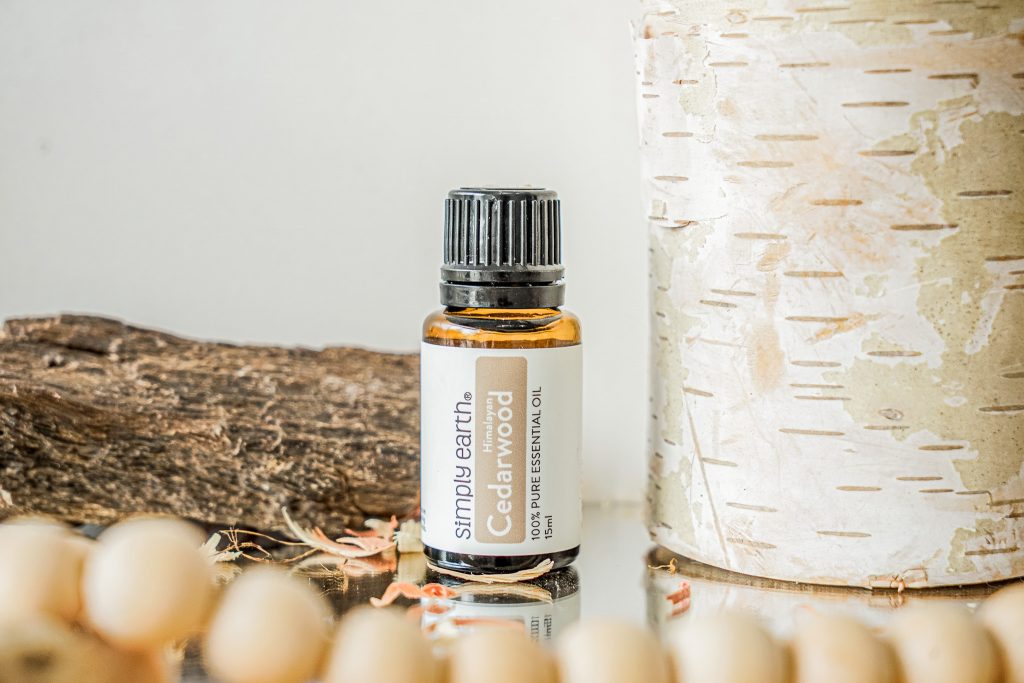
Regarding Cedarwood Essential Oils, the Himalayan and Atlas varieties each bring unique characteristics, captivating users with their distinctive aromas and benefits. The Himalayan variety, extracted from trees grown in the majestic mountains of the Himalayas, offers a slightly sweeter fragrance with stronger middle notes, making it a perfect choice for those seeking a soothing yet invigorating aroma. In contrast, the Atlas Cedarwood, hailing from the Atlas Mountains in Morocco, tends to have a more earthy and rich scent with woody undertones, providing a grounding experience that many find calming and stabilizing.
But the differences don’t stop at the aroma! The Himalayan Cedarwood is celebrated for its ability to promote relaxation and support respiratory health, making it a go-to option for meditation practices and natural remedies to combat congestion. On the other hand, Atlas Cedarwood is renowned for its potent antiseptic and anti-inflammatory properties, which makes it an excellent addition to skincare routines, particularly for combating acne and soothing irritated skin.
Cedarwood Essential Oil Benefits
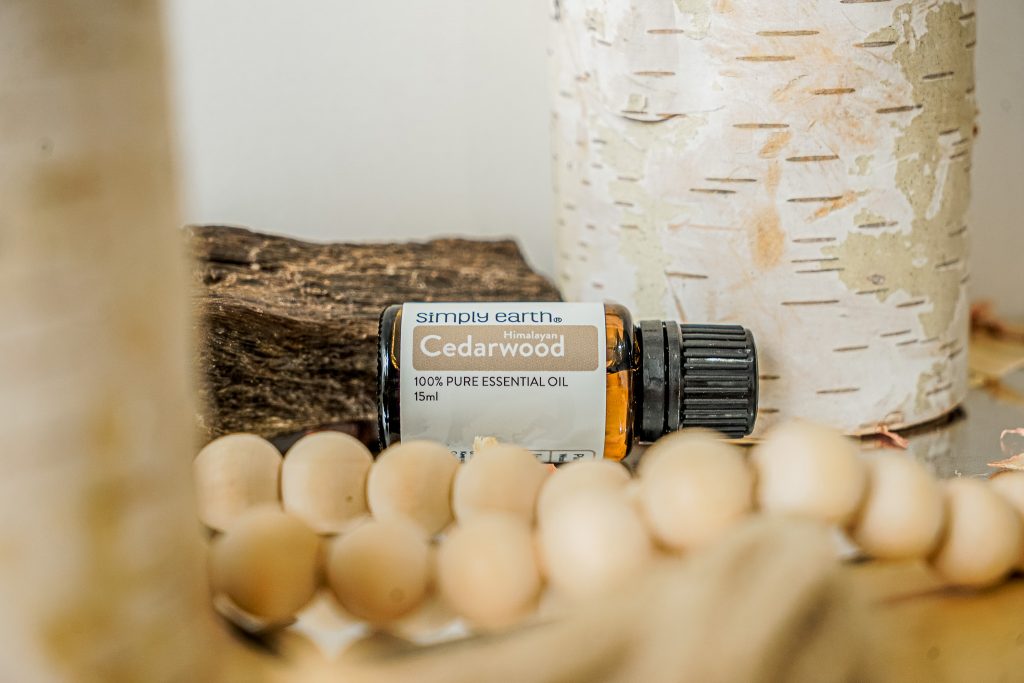
Supports Respiration
Cedarwood Essential Oil is a remarkable ally for maintaining a healthy respiratory system. A study¹ shows anti-inflammatory and analgesic properties that work wonders in soothing respiratory tract inflammation, making breathing easier and more comfortable.
Centers
Another profound benefit of Cedarwood Essential Oil is its ability to foster a tranquil environment. Research² indicates its significant anxiolytic activity, suggesting that Cedarwood Oil could be a promising aid in reducing anxiety and stress levels. This makes it an ideal choice for those seeking natural methods to achieve mental calm and stability.
Soothes Skin
Cedarwood Essential Oil is great for troubled, sensitive, or damaged skin. A review³ of its uses reveals that Cedarwood Oil has anti-inflammatory properties, is a potent ally in skincare, and is a sought-after ingredient in formulations aimed at calming inflammation and reducing redness.
Promotes Rest
One of the most sought-after benefits of Cedarwood Essential Oil is its profound ability to encourage healthy sleep patterns. A pivotal study⁴ has showcased that cedrol, a major component found in Cedarwood Oil, possesses marked sedative effects upon inhalation. This incredible characteristic not only aids in hastening the process of falling asleep but also enhances the quality of sleep, ensuring you wake up feeling revitalized and ready to tackle the day ahead.
Cleanses Skin
Cedarwood Essential Oil plays a pivotal role in cleansing the skin. Emerging research⁵ highlights its antifungal potential, revealing that Cedarwood Oil can effectively combat various fungal strains often resistant to traditional treatments.
Deters Insects
The woody, earthy aroma of Cedarwood Essential Oil acts as a robust deterrent to unwanted insects, keeping your spaces bug-free and serene. Scientific research⁶ has unveiled the insecticidal action of Cedarwood Oil. It also highlighted its potential as a botanical larvicide, revealing a promising avenue for its use in integrated pest management strategies.
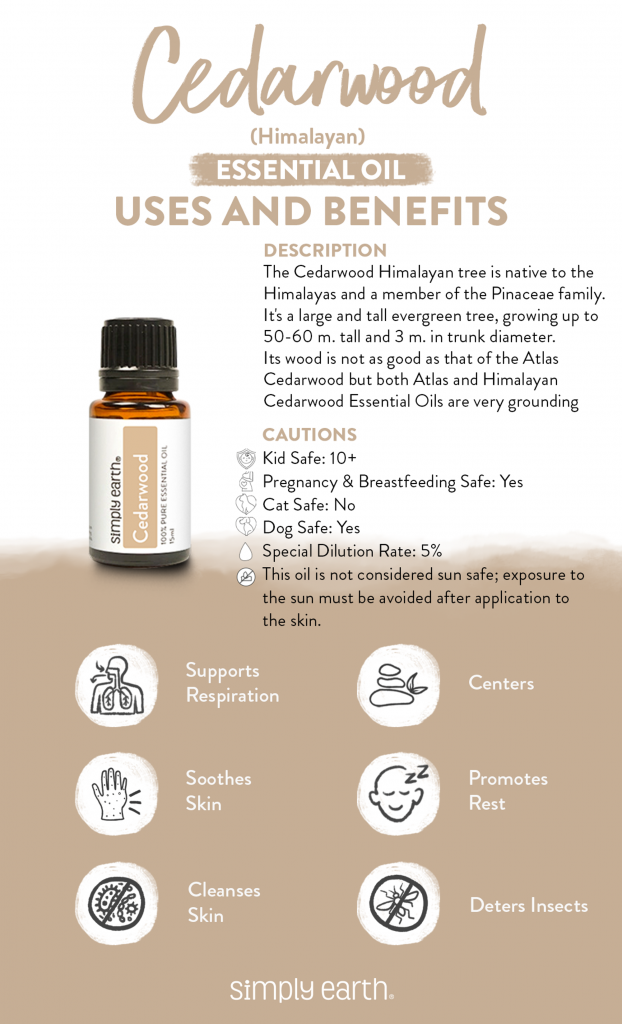
Cedarwood Himalayan Uses & Recipes
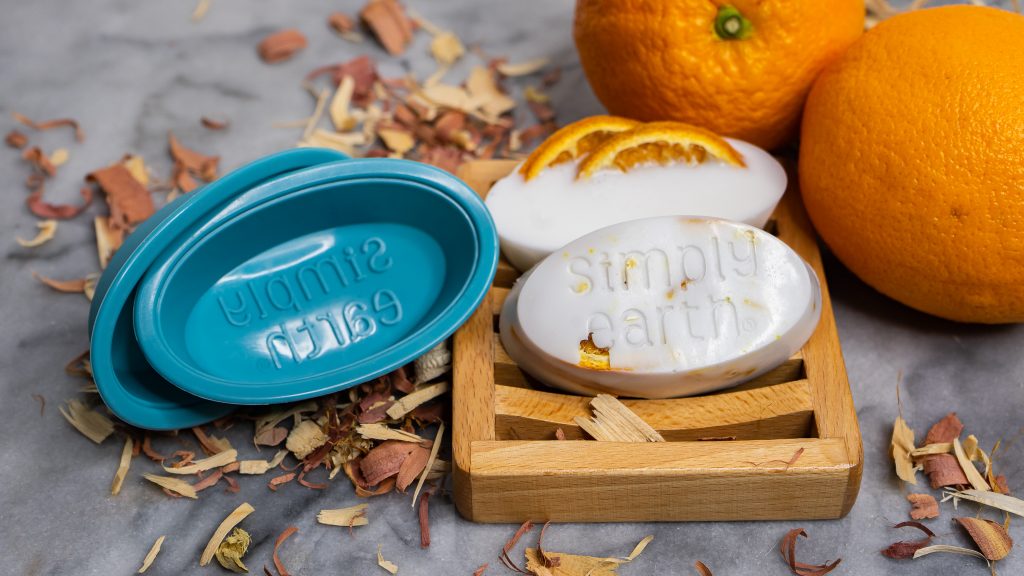
For Relaxation Recipes
Cedarwood Himalayan Oil can be seamlessly incorporated into relaxation recipes to create a serene and sleep-friendly environment. These simple yet powerful recipes leverage the natural properties of Cedarwood Oil to calm the mind, soothe the senses, and promote a state of peaceful slumber.
Personal and Skin Care Recipes
Cedarwood Essential Oil is a powerful ingredient in personal and skin care recipes. Its woody, soothing scent and beneficial properties make it ideal for those looking to enhance their beauty routines naturally.
- Santa’s Fir Needle Beard Oil
- Winter Skin Protection Balm
- Orange Grove Exfoliating Soap
- DIY Custom Dry Shampoo
Roll-On Recipes
Cedarwood Himalayan Essential Oil is also a star ingredient in roll-on recipes, offering a convenient and mess-free way to enjoy its benefits on the go.
Diffuser Blend Recipes
Cedarwood Essential Oil can create ambiance and influence mood through diffuser blend recipes. Introducing these oils into your diffuser can transform any space into a tranquil haven, imbue your home with a grounding aura, or energize your surroundings, depending on the combination of oils used.
- Smell Like Summer Diffuser Blend
- September Stroll Diffuser Blend
- Respiration Support Diffuser Blend
- Bubbly Diffuser Blend
Cedarwood Himalayan Essential Oil Blends Well With
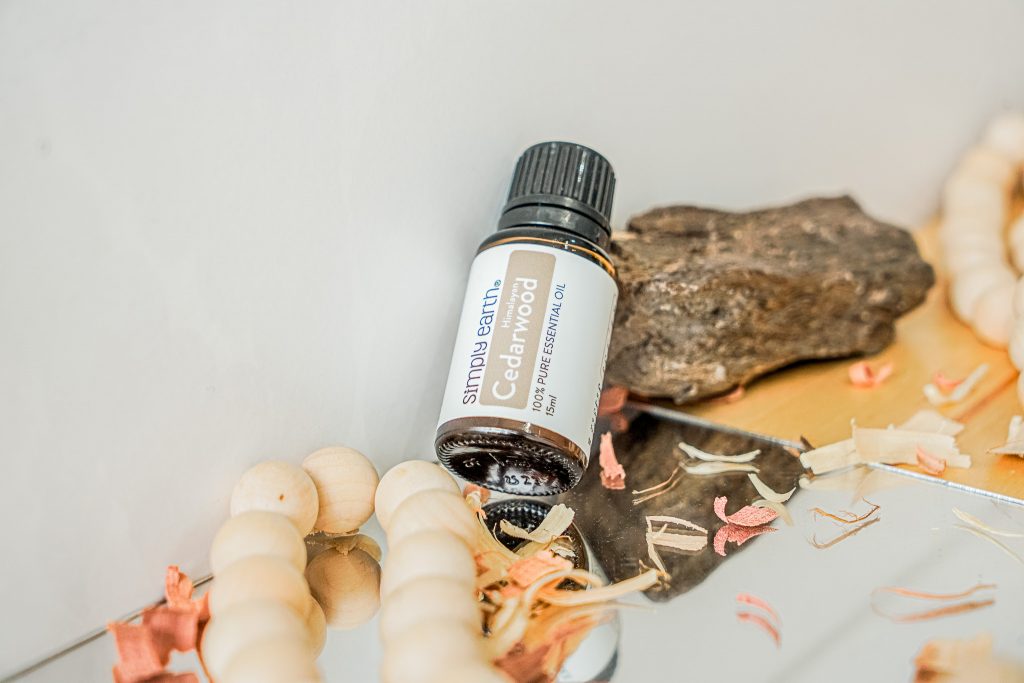
The woody and fresh aroma of Cedarwood Oil smells like a pile of fresh cedarwood shavings.
Cedarwood Essential Oil blends well with Bergamot, Cypress, Cassia, Jasmine, Juniper Berry, Neroli, Frankincense, Clary Sage, Vetiver, Rosemary, and Ylang-ylang Essential Oils.
Simply Earth Blends That Use This Oil
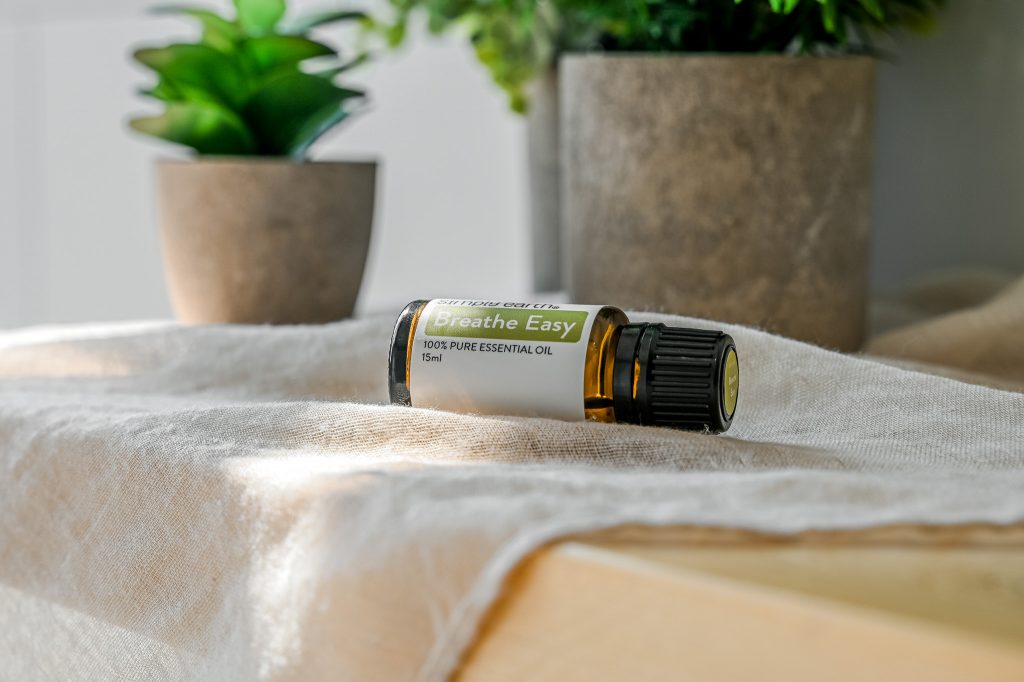
Breathe Easy Blend
Aroma: Fresh
Breathe Easy Essential Oil Blend supports your respiratory system to help you breathe easier.
Also Available: Breathe Easy Essential Oil Roll-On
Peace & Quiet Blend
Aroma: Floral & Citrusy
Use Peace & Quiet Essential Oil Blend, which has the calming aroma of Cedarwood Essential Oil, to help you relax.
Also Available: Peace & Quiet Essential Oil Roll-On
Sweet Dreams Blend
Aroma: Floral & Sweet
Sweet Dreams Essential Oil Blend is a kid-safe blend that is a great way to help your kiddos relax before bedtime.
Timber Blend
Aroma: Woody with Notes of Vanilla
Timber Essential Oil Blend is great for gentle skin care with a masculine scent.
What’s the Science Behind This Oil?
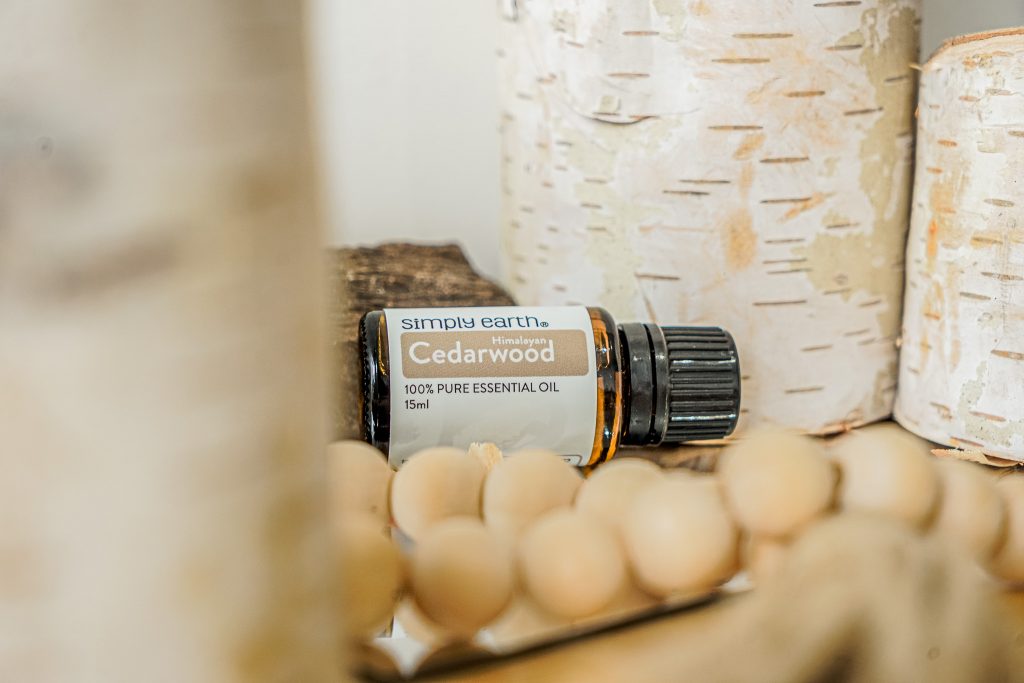
History of Himalayan Cedarwood
The historical significance of Cedarwood (Himalayan) extends back to biblical times, underscoring its importance in ancient civilization. It was highly valued for its durability and resistance to decay, making it an ideal material for constructing temples, homes, boats, and even torches. Its aromatic wood was not only used for building but also for its preserving qualities. In contemporary times, the focus on Cedarwood (Himalayan) has shifted towards its therapeutic benefits. This essential oil is celebrated for its remarkable effects on skin and respiratory health. Its anti-inflammatory and antiseptic properties make it a potent remedy for various skin issues, while its calming aroma helps soothe the respiratory system. Furthermore, Cedarwood (Himalayan) oil is increasingly recognized for its ability to alleviate emotional tension, providing a natural means for relaxation and mental clarity.
Chemical Constituents
β-Himachalene
Beta-himachalene is a metabolite produced during a metabolic reaction in plants, the kingdom that includes flowering plants, conifers, and other gymnosperms. It is known to have antimicrobial activity.
α-Himachalene
Alpha-Himachalene is a natural product found in plants, the kingdom that includes flowering plants, conifers, and other gymnosperms. It is known to have airborne antituberculosis activity
What Earthies Are Saying About This Oil

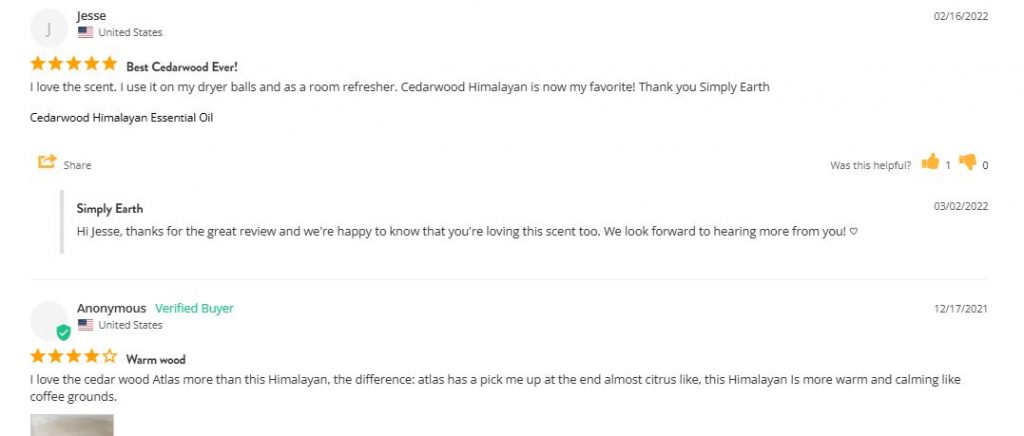
Things to Remember When Using This Oil

Always dilute an essential oil when using it on the skin. This essential oil is unlikely to cause skin irritation when diluted properly. If the oil has been oxidized (left with the cap off for long periods of time) it is more likely to cause skin irritation. Check out this dilution chart for diluting this essential oil properly.

When using essential oils around children, caution should be taken.

This essential oil is generally safe to diffuse and use topically on cats. For more information on using essential oils with cats, check out this blog post.

For more information on using essential oils with dogs, check out this blog post.
We don’t recommend ingesting essential oils unless under the direction of a doctor certified in aromatherapy. For more information on why we don’t ingest essential oils check out this blog post.
*Please note: This post is a compilation of suggestions made by those that have extensively used essential oils and has not been verified scientifically with clinical tests nor reviewed by medical experts. It is anecdotal information and should be treated as such. For serious medical concerns, please consult your doctor. The statements given in this blog post have not been verified by the FDA
References:
- Kagawa D, Jokura H, Ochiai R, Tokimitsu I, Tsubone H. The sedative effects and mechanism of action of cedrol inhalation with behavioral pharmacological evaluation. 2003 Jul
- Eller FJ, Vander Meer RK, Behle RW, Flor-Weiler LB, Palmquist DE. Bioactivity of cedarwood oil and cedrol against arthropod pests. Environ Entomol. 2014 Jun
- Lauren A. Hassoun, Jennifer N. Ornelas, Raja K. Sivamani. Cedarwood Oil as Complementary Treatment in Refractory Acne. 2016 Mar
- Zhang K, Yao L. The anxiolytic effect of Juniperus virginiana L. essential oil and determination of its active constituents. 2018 May
- Hay IC, Jamieson M, Ormerod AD. Randomized trial of aromatherapy. Successful treatment for alopecia areata. Arch Dermatol. 1998 No

